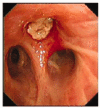Classic biphasic pulmonary blastoma: a case report and review of the literature
- PMID: 33107372
- PMCID: PMC7645427
- DOI: 10.1177/0300060520962394
Classic biphasic pulmonary blastoma: a case report and review of the literature
Abstract
Pulmonary blastoma (PB) is a very rare malignant lung tumor consisting of classic biphasic PB, well-differentiated fetal adenocarcinoma, and pleuropulmonary blastoma. We herein present an unusual case involving a patient with classic biphasic PB who underwent right upper lobe resection and subsequent treatment. No standard treatment guidelines are available for PB because of its rarity. Our patient received nedaplatin plus paclitaxel as adjuvant chemotherapy. After disease recurrence, the patient received two cycles of etoposide-cisplatin and six cycles of pemetrexed, bevacizumab, and carboplatin. Because of severe adverse effects of the chemotherapy, the patient was finally administered anlotinib, a new oral multikinase inhibitor. Both the tumor size and the serum tumor marker concentration decreased. In conclusion, surgical excision is the treatment of choice for PB. Chemotherapy in the present case resulted in PB activity that was consistent with the literature. Targeted therapies including antiangiogenic agents should be considered as a new treatment option for this rare disease.
Keywords: Pulmonary blastoma; alpha-fetoprotein; anlotinib; chemotherapy; surgical excision; targeted therapy.
Conflict of interest statement
Figures





References
-
- Van Loo S, Boeykens E, Stappaerts I, et al. Classic biphasic pulmonary blastoma: a case report and review of the literature. Lung Cancer 2011; 73: 127–132. - PubMed
-
- Brambilla E, Travis WD, Colby TV, et al. The new World Health Organization classification of lung tumours. Eur Respir J 2001; 18: 1059–1068. - PubMed
Publication types
MeSH terms
Substances
LinkOut - more resources
Full Text Sources
Medical

